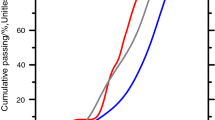Abstract
Cementitious materials in terms of calcium phosphate cements (CPC) were prepared through the acid-base reaction between vinylphosphonic acid (VPA) and calcium aluminate cement (CAC) reactants or calcium silicate cement (CSC) reactants at 25 °C. Using CAC, two factors were responsible for the development of strength in the cements: one is the formation of an amorphous calcium-complexed vinylphosphonate (CCVP) salt phase as the reaction product, and the other was the high exothermic reaction energy. Because the formation of CCVP depletes the calcium in the CAC reactants, Al2O3·xH2O gel was precipitated as a by-product. CCVP→ amorphous calcium pyrophosphate hydrate (CPPH) and Al2O3·xH2O → γ-AlOOH phase transitions occurred in the CPC body autoclaved at 100 °C. Increasing the temperature to 200 °C promoted the transformation of CPPH into crystalline hydroxyapatite (HOAp). In the VPA-CSC system, the strong alkalinity of CSC reactant with its high CaO content served in forming the CPPH reaction product which led to a quick setting of the CPC at 25 °C. Hydrothermal treatment at 100 °C resulted in the CPPH → HOAp phase transition, which was completed at 300 °C for both the VPA-CAC and VPA-CSC systems, and also precipitated the silica gel as by-product. Although the porosity of the specimens was one of the important factors governing the improvement of strength, a moderately mixed phase of amorphous CPPH and crystalline HOAp as the matrix layers contributed significantly to strengthening of the CPC specimens.
Similar content being viewed by others
References
T. Sugama and N. R. Carciello, J. Am. Ceram. Soc. 74 (1991) 1023.
T. Sugama, M. Allan and J. M. Hill, ibid. 75 (1992) 2076.
T. Sugama and N. R. Carciello, Cem. Concr. Res. 25 (1995) 91.
Idem, ibid. 23 (1993) 1409.
J. Ellis and A. D. Wilson, J. Mater. Sci. Lett. 9 (1990) 1058.
M. J. O'Neal, Anal. Chem. 36 (1964) 1238.
M. G. Wyzgoski, J. Appl. Polym. Sci. 25 (1980) 1455.
L. C. Thomas and R. A. Chittenden, Spectrochim. Acta. 26A (1970) 781.
J. Ellis and A. D. Wilson, Polym. Int. 24 (1991) 221.
D. E. C. Corbridge, and E. J. Lowe, J. Chem. Soc. (1954) 493.
E. Z. Arlidge, V. C. Farmer, B. D. Mitchell and W. A. Mitchell, J. Appl. Chem. 13 (1963) 17.
T. Sugama and N. R. Carciello, Adv. Cem. Res. 5 (1993) 31.
R. A. Nyquist and R. O. Kagel, “Infrared Spectra of Inorganic Compounds” (Academic Press, New York, 1971) p. 95.
Author information
Authors and Affiliations
Rights and permissions
About this article
Cite this article
Sugama, T., Mora, R.N. Vinylphosphonic acid-modified calcium aluminate and calcium silicate cements. JOURNAL OF MATERIALS SCIENCE 31, 6269–6278 (1996). https://doi.org/10.1007/BF00354449
Received:
Accepted:
Published:
Issue Date:
DOI: https://doi.org/10.1007/BF00354449




